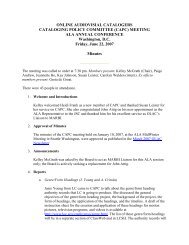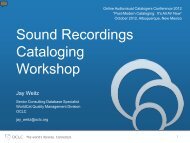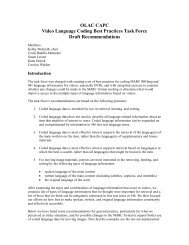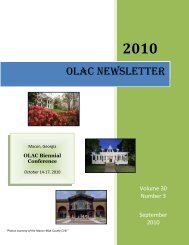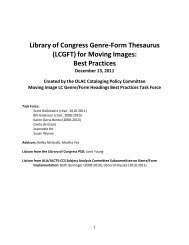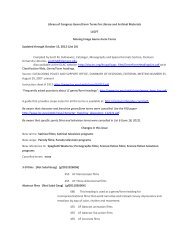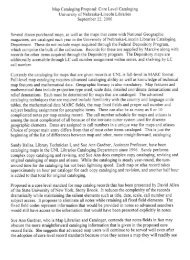see workshop handouts - OLAC
see workshop handouts - OLAC
see workshop handouts - OLAC
Create successful ePaper yourself
Turn your PDF publications into a flip-book with our unique Google optimized e-Paper software.
PROJECTIO1V refers to the system used to represent information about the spherical surface of the earth on a<br />
flat surface. There are many different types of projection. You don’t need to understand any of them to<br />
catalog a map.<br />
Transcribe a statement of projection found on the map, its container or case, or accompanying printed<br />
material in the mathematicaf data (255) area. Transcribe the statement in English, regardless of the language<br />
in which it appears; use standard abbreviations (e.g., “proj.” for “projection”) and numerals in place of words.<br />
Capitalize proper names. (Cartographic Materials, 3C) (Note: Map Cataloging Manual, p. 2.5, says to<br />
capitalize first word as well. OCLC’s manual follows LC.)<br />
255 Scale 1: 150,000 ; +b Transverse Mercator proj.<br />
COORDINATES referto the geographical grid lines used to pinpoint locations on the earth.<br />
--Longitude lines (or “meridians”) run north/south between the poles.<br />
--Latitude lines (or “parallels”) run east/west parallel to the equator.<br />
Both sets of lines are measured in degrees, minutes, and seconds from a standard base line (the number<br />
represents the angle measured between the subject line and the base line through the center of the earth).<br />
--For longitude, the standard base line (or “prime meridian”) is usually the line which passes through<br />
Greenwich, England. It can be other lines, however, since Greenwich is significant for Great Britain but<br />
not necessarily for other countries. Older maps often have non-Greenwich prime meridians, such as<br />
Amsterdam, Paris, Washington, DC, etc. Longitude is counted 180’ east or west from the prime<br />
meridian. Record longitude from westernmost to easternmost points.<br />
--For latitude, the standard base line is the equator. Latitude is counted 90’ north or south from the<br />
equator. Record latitude from northernmost to southernmost points.<br />
034 1 a +b 1000 +d W1013015 se WO203000 +fN0490000 +g NO343015<br />
255 Scale l:l,OOO+c(W 101°30’15”--W20° 30’ OO”/N49O 00’ 00” --N34’30’ 15”).<br />
NOTE: Record only coordinates based on Greenwich and the equator in the mathematical data (255) area.<br />
Coordinates for the moon, planets, and other celestial bodies can be given in a note.<br />
500 Lunar coordinates: E 15’--E 17’/S 8’--S 9’.<br />
INPUTTING TIP: The correct symbols for degrees, minutes, and seconds are special characters:<br />
Degrees: Superscript zero (“)<br />
Minutes (and feet): Miagkii znak ( ’ )<br />
Seconds (and inches): Tverdyi znak (“)<br />
AVGGLAC96 10



